The Effect of Vibrations from Racing Cars on the Human Body in FORMULA STUDENT Races
Abstract
:Featured Application
Abstract
1. Introduction
2. Materials and Methods
3. Results
4. Discussion and Conclusions
- The movement of vehicles is accompanied by the permanent appearance of vibrations and shocks. These vibrations are transmitted to the level of the sprung and unsprung masses of the vehicles, considerably influencing the comfort of the passengers and the durability of the components of the body, suspension, transmission and engine.
- In the case study carried out, the way these vibrations are felt in the head, thorax and pelvis of a kart driver was studied based on perturbations coming from various sources, such as road irregularities or engine excitations. These excitations were considered sinusoidal with a unit amplitude of displacement. The range considered for the forced vibration study was 0–100 Hz.
- As can be seen from the results, the largest displacements of the analyzed cases were obtained in case 3 near the eigenmode 35. The obtained value was approximately 8.75 mm at head level. Slightly lower values on the same frequency were obtained on the chest and pelvis.
- If we analyze the stress level in the chassis structure, it can be seen that a high level of stress appears in the area where the seat belt is fastened. Since the connection between the belt and the chassis structure is made through rigid connections that introduce infinite rigidity, this value is actually lower since the components that make the belt-chassis connection are flexible.
- For the excitation applied to the rear wheels (left or right wheel), the largest displacement responses at head level were obtained on eigenmodes 19 and 29. The values are about 3.5 mm, significantly lower than those obtained in case 3.
- For the excitations applied to the front wheels, the response values of the displacements at the dummy head level are 6 mm on the normal mode vibration 12, somewhere between those from the other excitation sources analyzed.
- As a final conclusion, from all excitation sources surveyed, it seems that the highest output displacement values on the dummy were obtained for the third case with excitation applied to the engine zone. Additionally, from a structural point of view, the highest stress level is obtained from this case, too.
Author Contributions
Funding
Institutional Review Board Statement
Informed Consent Statement
Data Availability Statement
Conflicts of Interest
Appendix A
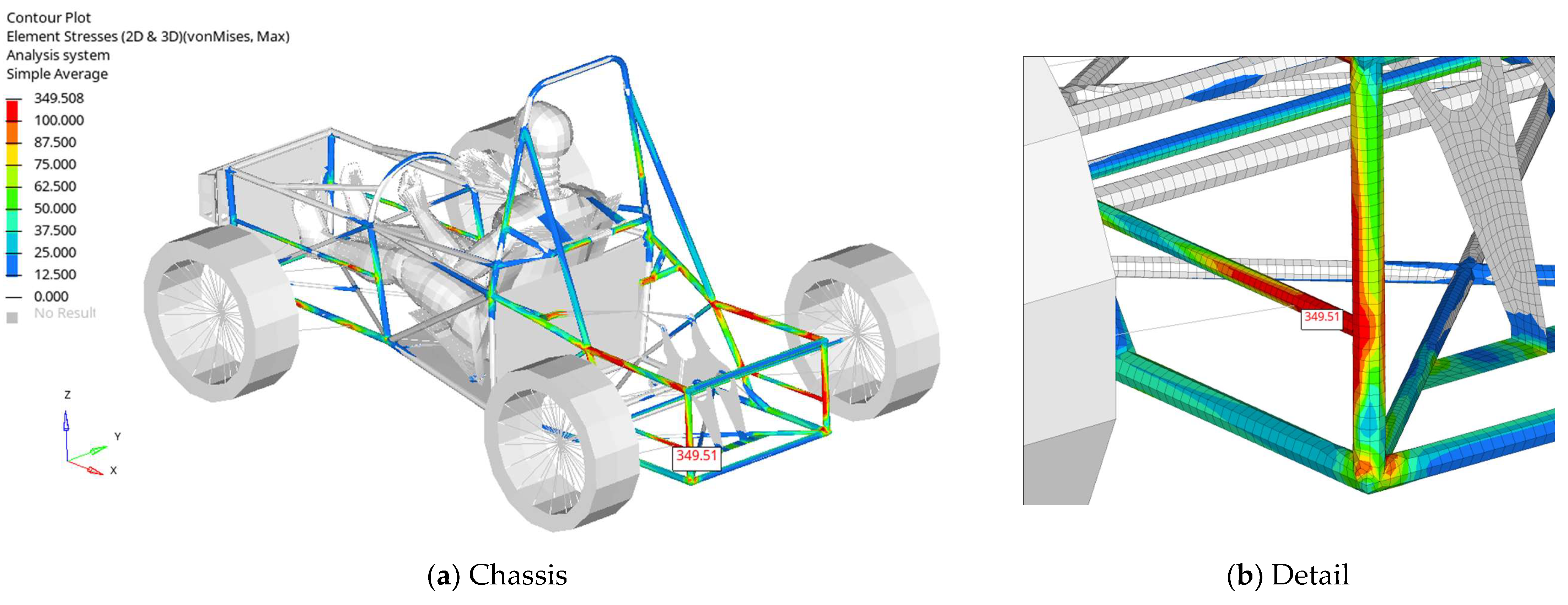
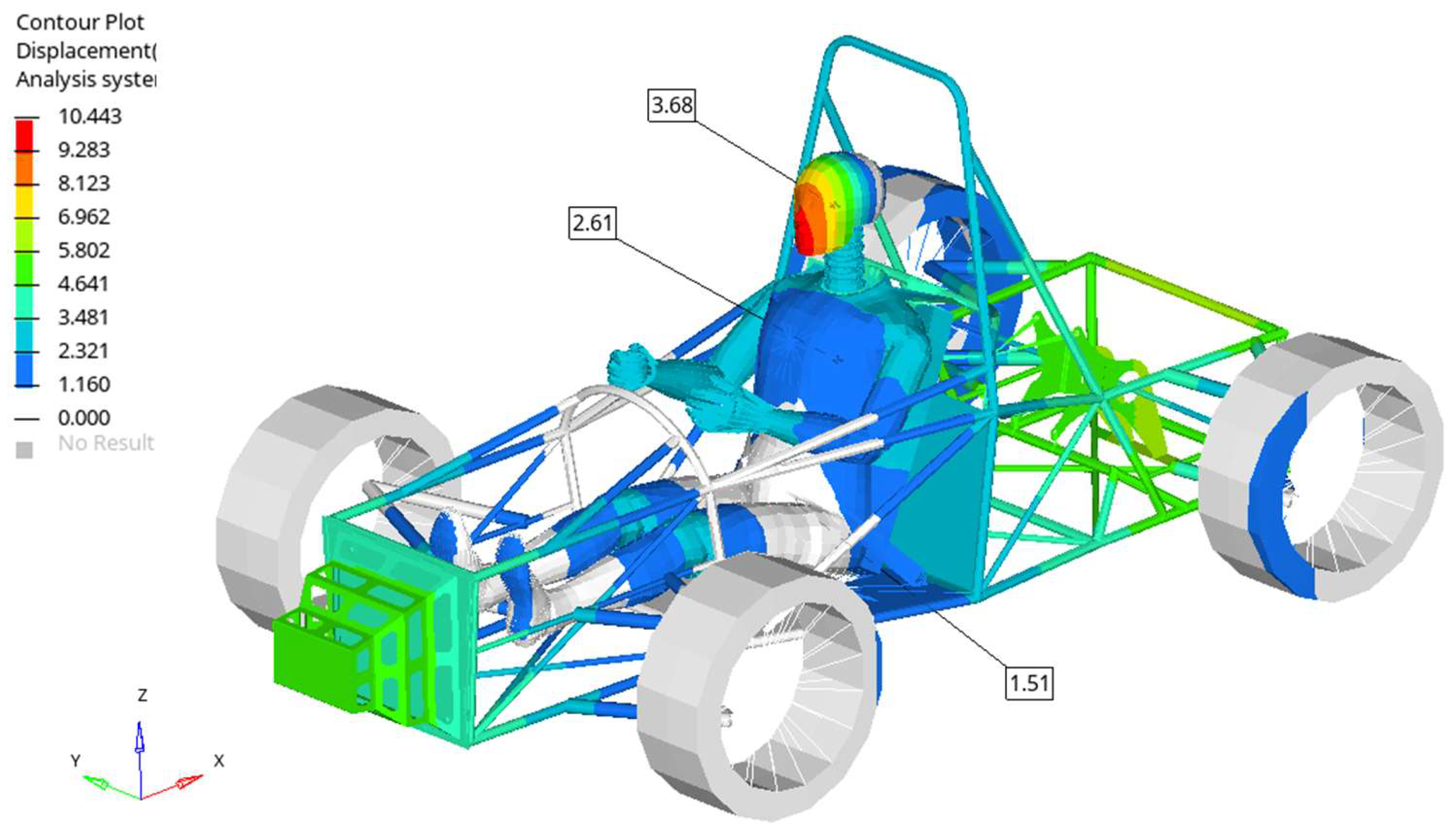
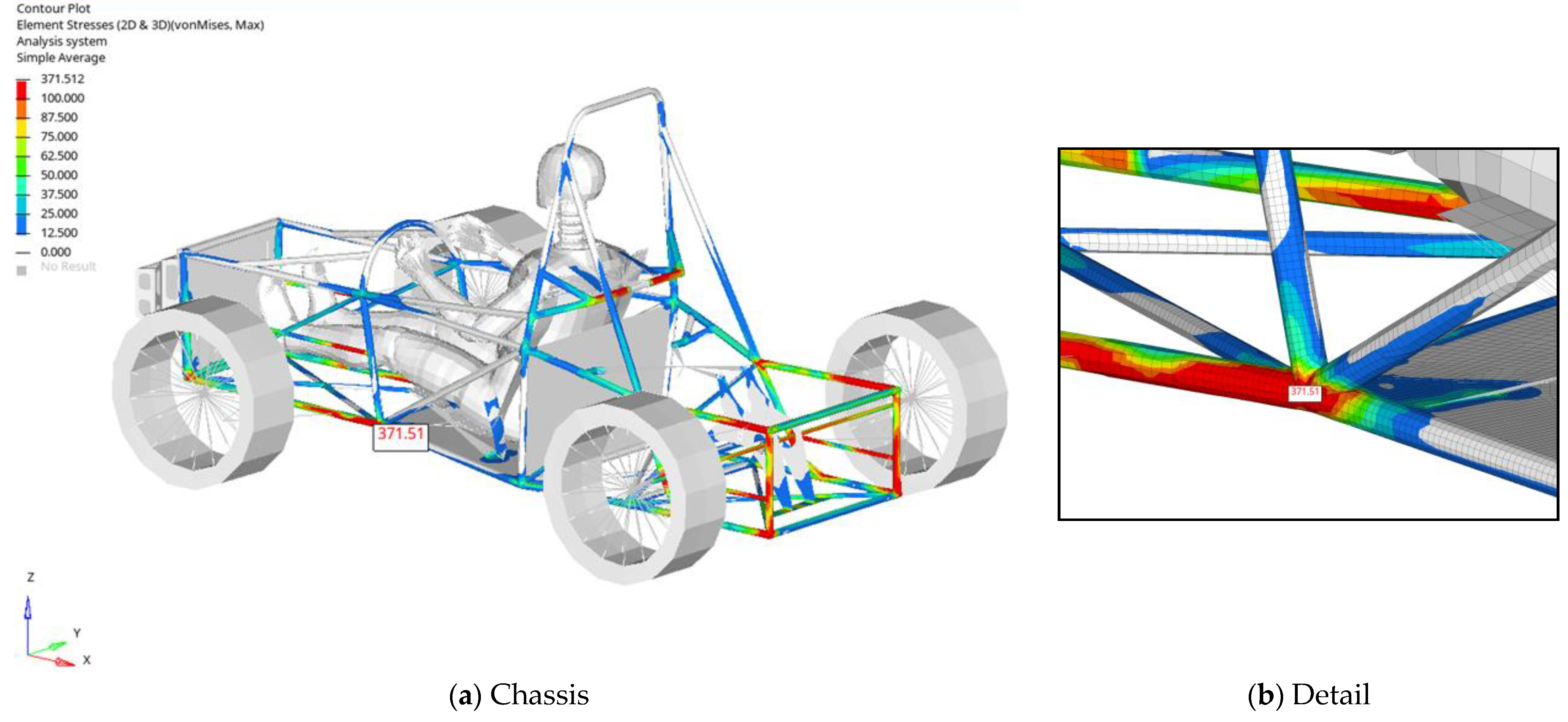
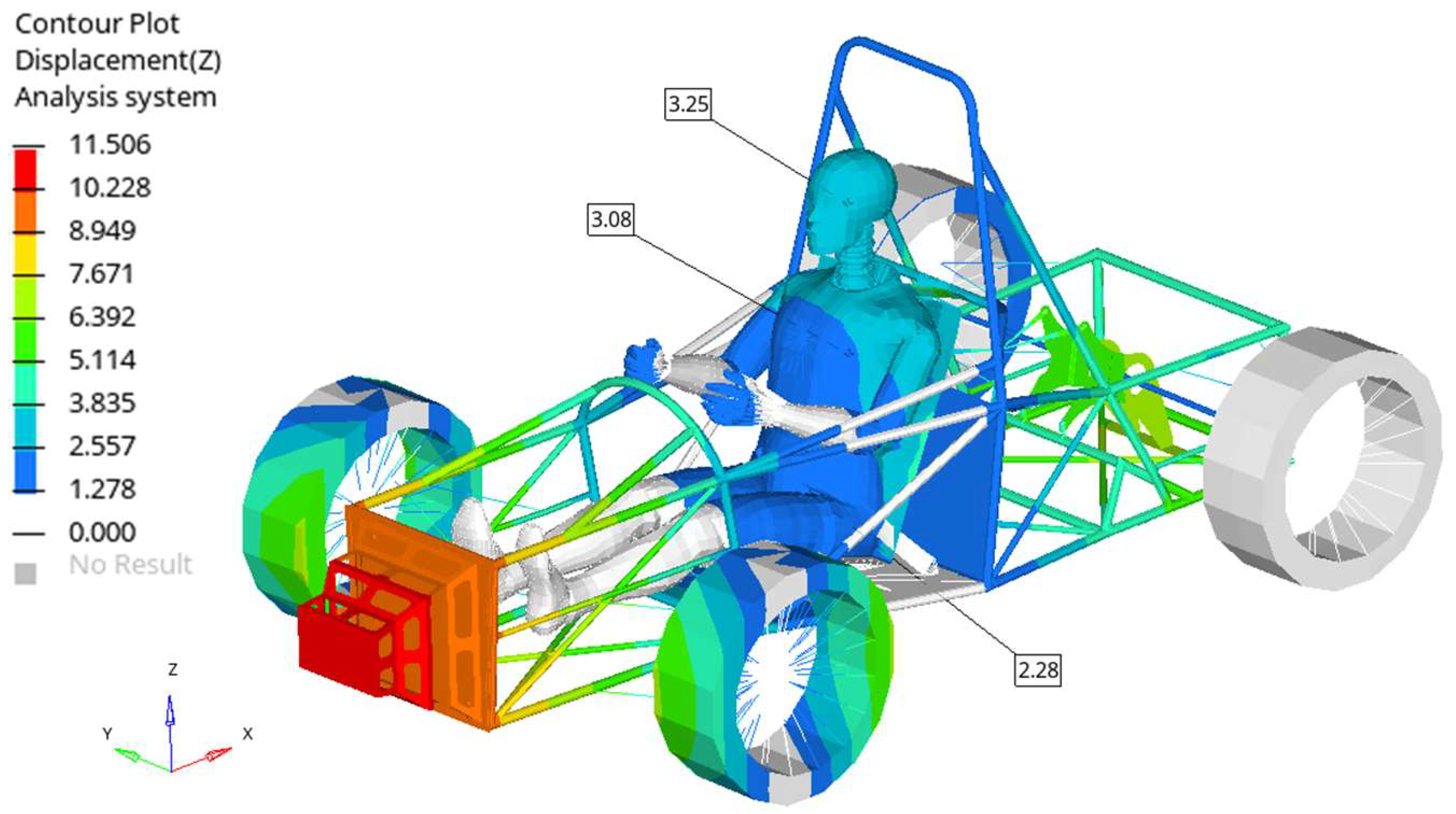
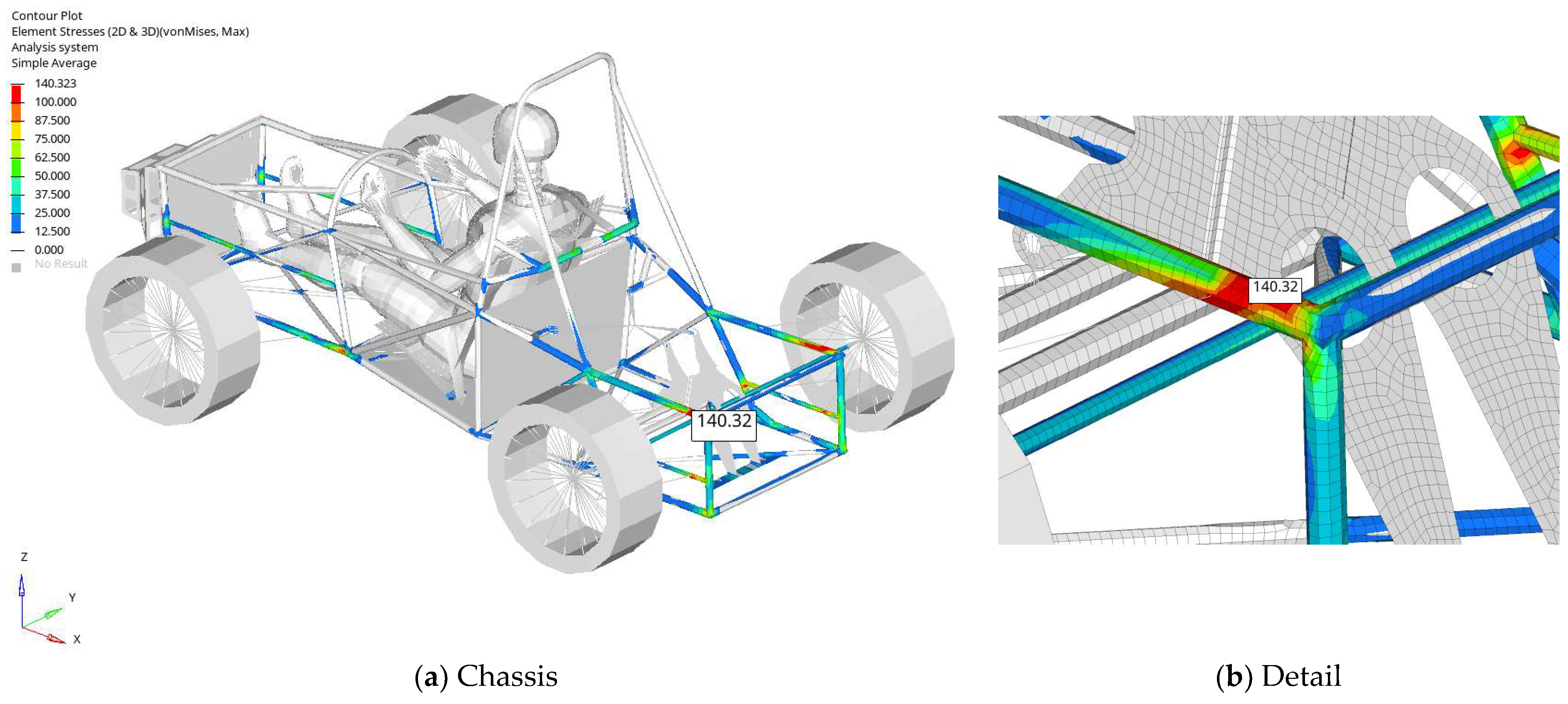


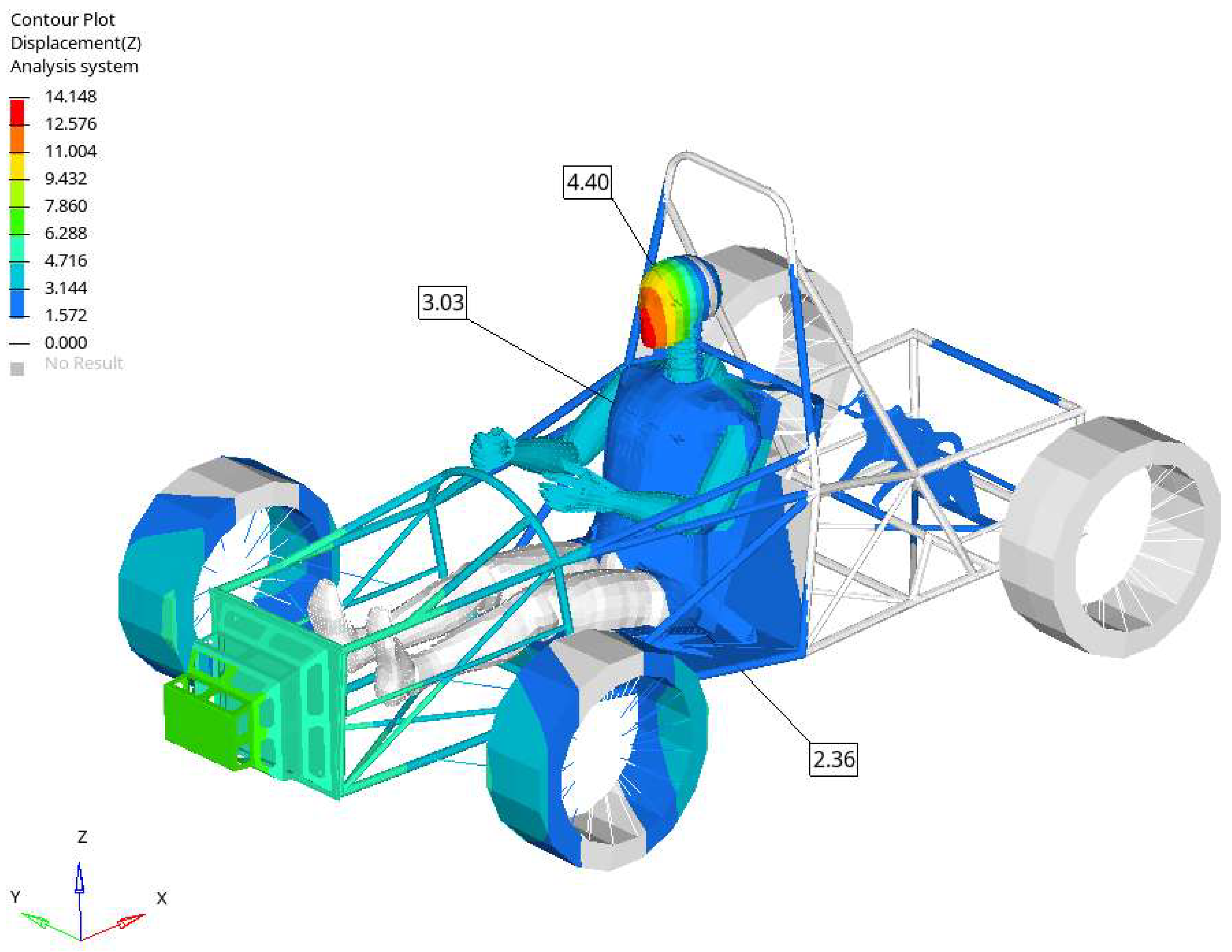
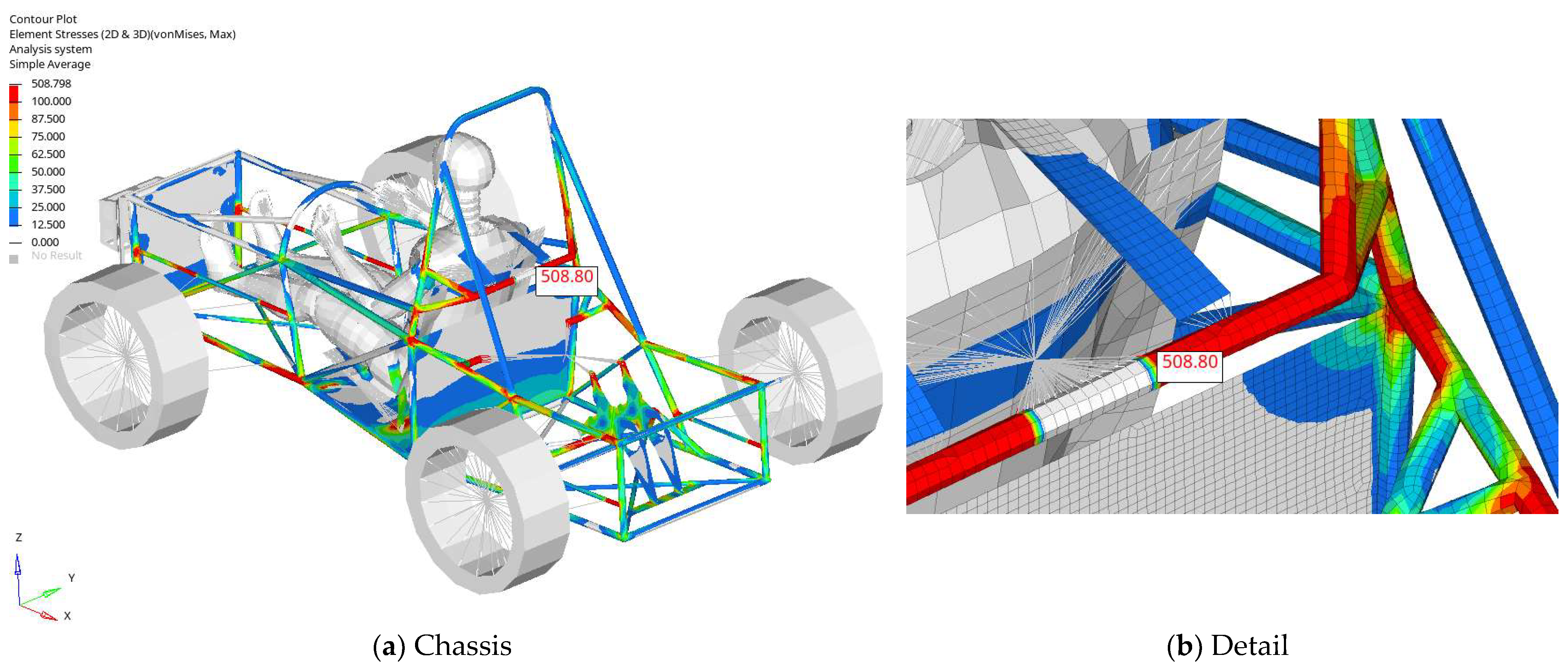

References
- Gobbi, M.; Mastinu, G.; Doniselli, C. Optimising a car chassis. Veh. Syst. Dyn. 1999, 32, 149–170. [Google Scholar] [CrossRef]
- Sani, M.S.M.; Rahm2an, M.M.; Noor, M.M.; Kadirgama, K.; Izham, M.H.N. Identification of Dynamics Modal Parameter for Car Chassis. IOP Conf. Ser. Mater. Sci. Eng. 2011, 17, 012038. [Google Scholar] [CrossRef]
- Silva, A.F.; Mendes, P.M.; Correia, J.H.; Goncalves, F.; Ferreira, L.A.; Araujo, F.M.; Ferreira, L.A.; Araujo, F.M. Inner Car Smart Flooring for Monitoring Chassis Deformation. In Proceedings of the 8th IEEE Conference on Sensors, Christchurch, New Zealand, 25–28 October 2009; p. 1587. [Google Scholar]
- Chianola, S.; Gadola, M.; Leoni, L.; Resentera, M. On the design of a low-cost racing car chassis. In Proceedings of the DESIGN 2002: 7th International Design Conference, Dubrovnik, Croatia, 14–17 May 2002; Volume 1–2, pp. 1035–1040. [Google Scholar]
- bin Ab Razak, M.S.; bin Hasim, M.H.; bin Ngatiman, N.A. Design of Electric Vehicle Racing Car Chassis using Topology Optimization Method. MATEC Web Conf. 2017, 97, 01117. [Google Scholar] [CrossRef]
- Woo, S.; Ha, Y.; Yoo, J.; Josa, E.; Shin, D. Chassis Design Target Setting for a High-Performance Car Using a Virtual Prototype. Appl. Sci. 2023, 13, 844. [Google Scholar] [CrossRef]
- Juraeva, M.; Ryu, K.J.; Noh, S.H.; Song, D.J. Lightweight material for the speed reducer housing of a car chassis. J. Mech. Sci. Technol. 2017, 31, 3219–3224. [Google Scholar] [CrossRef]
- Feraboli, P.; Masini, A.; Bonfatti, A. Advanced composites for the body and chassis of a production high performance car. Int. J. Veh. Des. 2007, 44, 233–246. [Google Scholar] [CrossRef]
- Mat, M.H.; Ab Ghani, A.R. Design and Analysis of ‘Eco’ Car Chassis. Procedia Eng. 2012, 41, 1756–1760. [Google Scholar] [CrossRef]
- Zaman, Z.I.; Basaruddin, K.S.; Basha, M.H.; Abd Rahman, M.T.; Daud, R. Finite element prediction on the chassis design of UniART4 racing car. AIP Conf. Proc. 2017, 1885, 020110. [Google Scholar] [CrossRef]
- Tsirogiannis, E.C.; Stavroulakis, G.E.; Makridis, S.S. Optimised ultrafast lightweight design and finite element modelling of a CFRP monocoque electric chassis. Int. J. Electr. Hybrid Veh. 2019, 11, 255–287. [Google Scholar] [CrossRef]
- Anderson, D.T.; Mills, B. Dynamic Analysis of a Car Chassis Frame using Finite Element Method. Int. J. Mech. Sci. 1972, 14, 799. [Google Scholar] [CrossRef]
- Vlase, S.; Marin, M.; Bratu, P.; Shrrat, O.A.O. Analysis of Vibration Suppression in Multi-Degrees of Freedom Systems. Rom. J. Acoust. Vib. 2022, 19, 149–156. [Google Scholar]
- Wongchai, B. Front and Side Impact Analysis of Space Frame Chassis of Formula Car. Int. J. Geomate 2020, 18, 168–174. [Google Scholar] [CrossRef]
- Rao, P.K.V.; Putsala, K.S.K.; Muthupandi, M.; Mojeswararao, D. Numerical analysis on space frame chassis of a formula student race car. Mater. Today Proc. 2022, 66, 754–759. [Google Scholar] [CrossRef]
- Hazimi, H.; Ubaidillah, C.; Setiyawan, A.E.P.; Ramdhani, H.C.; Saputra, M.Z.; Imaduddin, F. Vertical Bending Strength and Torsional Rigidity Analysis of Formula Student Chassis. In Proceedings of the 3rd International Conference on Industrial, Mechanical, Electrical, and Chemical Engineering (ICIMECE 2017), Surakarta, Indonesia, 13–14 September 2017. [Google Scholar]
- Maniowski, M. Optimization of driver and chassis of FWD racing car for faster cornering. In Dynamics of Vehicles on Roads and Tracks, Proceedings of the 24th Symposium of the International-Association-for-Vehicle-System-Dynamics (IAVSD), Graz, Austria, 17–21 August 2015; Taylor & Francis Group: London, UK, 2016; pp. 77–86. [Google Scholar]
- Abdullah, M.A.; Mansur, M.R.; Tamaldin, N.; Thanaraj, K. Development of formula varsity race car chassis. IOP Conf. Ser. Mater. Sci. Eng. 2013, 50, 012001. [Google Scholar] [CrossRef]
- Mohammed, N.A.; Nandu, N.C.; Krishnan, A.; Nair, A.R.; Sreedharan, P. Design, Analysis, Fabrication and Testing of a Formula Car Chassis. Material Today-Proceedings. Mater. Today Proc. 2018, 5, 24944–24953. [Google Scholar] [CrossRef]
- Butler, D.; Karri, V. Race car chassis tuning using artificial neural networks. In Proceedings of the AI 2003: Advances in Artificial Intelligence, 16th Australian Conference on Artificial Intelligence, Perth, Australia, 3–5 December 2003; Volume 2903, pp. 866–877. [Google Scholar]
- Ionita, D.; Arghir, M. Considerations on the Lagrange Interpolation Method Applicable in Mechanial Engineering. Acta Tech. Napcensis Ser. Appl. Math. Mech. Eng. 2021, 64, 329–332. [Google Scholar]
- Negrean, I.; Crisan, A.V.; Vlase, S. A New Approach in Analytical Dynamics of Mechanical Systems. Smmetry 2020, 12, 95. [Google Scholar] [CrossRef]
- Bratu, P.; Nicolae, G.L.; Iacovescu, S.; Ion, D.; Cotoban, A. The Effect of the Symmetrical Elastic Nonlinearity on Structural Vibrations Transmitted by Dynamic Equipment on the Construction Envelope. Rom. J. Acoust. Vib. 2022, 19, 25–28. [Google Scholar]
- Vlase, S.; Purcarea, R.; Teodorescu-Draghicescu, H.; Calin, M.R.; Szava, I.; Mihalcica, M. Behavior of a new Heliopol/Stratimat300 composite laminate. Optoelectron. Adv. Mater.-Rapid Commun. 2013, 7, 569–572. [Google Scholar]
- Modrea, A.; Vlase, S.; Calin, M.R.; Peterlicean, A. The influence of dimensional and structural shifts of the elastic constant values in cylinder fiber composites. J. Optoelectron. Adv. Mater. 2013, 15, 278–283. [Google Scholar]
- Vlase, S.; Teodorescu-Draghicescu, H.; Calin, M.R.; Scutaru, M.L. Advanced Polylite composite laminate material behavior to tensile stress on weft direction. J. Optoelectron. Adv. Mater. 2012, 14, 658–663. [Google Scholar]
- Teodorescu-Draghicescu, H.; Vlase, S.; Scutaru, M.L.; Serbina, L.; Calin, M.R. Hysteresis effect in a three-phase polymer matrix composite subjected to static cyclic loadings. Optoelectron. Adv. Mater. Rapid Commun. 2011, 5, 273–277. [Google Scholar]
- Abo-Dahab, S.M.; Abouelregal, A.E.; Marin, M. Generalized Thermoelastic Functionally Graded on a Thin Slim Strip Non-Gaussian Laser Beam. Symmetry 2020, 12, 1094. [Google Scholar] [CrossRef]
- Itu, C.; Vlase, S. Impact Attenuator Design for Improvement of Racing Car Drivers’ Safety. Symmetry 2023, 15, 159. [Google Scholar] [CrossRef]
- Kim, S.K.; White, S.W.; Bajaj, A.K.; Davies, P. Simplified models of the vibration of mannequins in car seats. J. Sound Vib. 2003, 264, 49–90. [Google Scholar] [CrossRef]
- Rutzel, S.; Mischke, C.; Wolfel, H.P. Representation of a pliant human body surface for a Finite-Element Model used to simulate contact parameters. In Proceedings of the Conference on Human Vibrations, Darmstadt, Germany, 17–18 May 2004. [Google Scholar]
- Chauhan, P.; Sah, K.; Kaushal, R. Design, modeling and simulation of suspension geometry for formula student vehicles. Mater. Today Proc. 2021, 43, 17–27. [Google Scholar] [CrossRef]
- Rejab, M.N.A.; Abd Rahman, R.; Hamzah, R.I.R.; Hussain, J.I.I.; Ahmad, N.; Ismail, A. Measurement of Noise inside the Compartment and Vibration on Both Sides of Elastomeric Powertrain Mounts of Passenger Car. Appl. Mech. Mater. 2014, 471, 59–63. [Google Scholar] [CrossRef]
- da Silva, M.C.G. Measurements of comfort in vehicles. Meas. Sci. Technol. 2002, 13, R41–R60. [Google Scholar] [CrossRef]
- Miller, L.E.; Patalak, J.P.; Harper, M.G.; Urban, J.E.; Stitzel, J.D. Pilot Collection and Evaluation of Head Kinematics in Stock Car Racing. J. Biomech. Eng.-Trans. ASME 2023, 145, 031006. [Google Scholar] [CrossRef]
- Szczypinski-Sala, W.; Kot, A.; Hankus, M. The Evaluation of Vehicle Vibrations Excited with a Test Plate during Technical Inspection of Vehicle Suspension. Appl. Sci. 2023, 13, 11. [Google Scholar] [CrossRef]
- Lu, Y.K.; Khajepour, A.; Soltani, A.; Wang, Y.G.; Zhen, R.; Liu, Y.G.; Li, G.Q. Cab-Over-Engine truck cabins: A mathematical model for dynamics, driver comfort, and suspension analysis and control. Proc. Inst. Mech. Engineering. Part K J. Multibody Dyn. 2023, 237, 60–73. [Google Scholar] [CrossRef]
- Huo, Z.Y.; Luo, X.W.; Wang, Q.; Jagota, V.; Jawarneh, M.; Sharma, M. Design and simulation of vehicle vibration test based on virtual reality technology. NolineEngineering Model. Appl. 2022, 11, 500–506. [Google Scholar] [CrossRef]
- Cano-Moreno, J.D.; Becerra, J.M.C.; Reina, J.M.A.; Marcos, M.E.I. Analysis of E-Scooter Vibrations Risks for Riding Comfort Based on Real Measurements. Machines 2022, 10, 688. [Google Scholar] [CrossRef]
- Asua, E.; Gutierrez-Zaballa, J.; Mata-Carballeira, O.; Ruiz, J.A.; del Campo, I. Analysis of the Motion Sickness and the Lack of Comfort in Car Passengers. Appl. Sci. 2022, 12, 3717. [Google Scholar] [CrossRef]
- Borowski, J.; Stetter, R.; Rudolph, S. Design, Dimensioning and Simulation of Inerters for the Reduction of Vehicle Wheel Vibrations-Case Studies. Vehicles 2020, 2, 424–437. [Google Scholar] [CrossRef]
- Saurabh, Y.S.; Kumar, S.; Jain, K.K.; Behera, S.K.; Gandhi, D.; Raghavendra, S.; Kalita, K. Design of Suspension System for Formula Student Race Car. Procedia Eng. 2016, 144, 1138–1149. [Google Scholar] [CrossRef]
- Wu, J.; Qiu, Y. The Study of Seat Vibration Transmission of a High-Speed Train Based on an Improved MISO Method. Mech. Syst. Signal Process. 2020, 143, 106844. [Google Scholar] [CrossRef]
- Fairley, T.E.; Griffin, M.J. The Apparent Mass of the Seated Human Body: Vertical Vibration. J. Biomech. 1989, 22, 81–94. [Google Scholar] [CrossRef]
- Griffin, M. Handbook of Human Vibration; Academic Press: London, UK, 1990. [Google Scholar]
- Nawayseh, N. Non-LineDual-Axis Biodynamic Response to Vertical Whole-Body Vibration. J. Sound Vib. 2003, 268, 503–523. [Google Scholar] [CrossRef]
- ISO 2631–1; Mechanical Vibration and Shock—Evaluation of Human Exposure to Whole-Body Vibration—Part1: General Requirements. ISO: Geneva, Switzerland, 1997.
- ISO 2631-4; Mechanical Vibration and Shock—Evaluation of Human Exposure to Whole-Body Vibration—Part 4: Guidelines for the Evaluation of the Effects of Vibration and Rotational Motion on Passenger and Crew Comfort in Fixed-Guideway Transport Systems. ISO: Geneva, Switzerland, 2001.
- Sun, C.; Liu, C.; Zheng, X.; Wu, J.; Wang, Z.M.; Qiu, Y. An analytical model of seated human body exposed to combined fore-aft, lateral, and vertical vibration verified with experimental modal analysis. Mech. Syst. Signal Process. 2023, 200, 110527. [Google Scholar] [CrossRef]
- Kia, K.; Johnson, P.W.; Kim, J.H. The effects of different seat suspension types on occupants physiologic responses and task performance: Implications for autonomous and conventional vehicles. Appl. Ergon. 2021, 93, 103380. [Google Scholar] [CrossRef]
- Zhao, Y.L.; Bi, F.R.; Shu, H.L.; Guo, L.C.; Wang, X. Prediction of the driver’s head acceleration and vibration isolation performance of the seating suspension system using the time and frequency domain modeling. Appl. Accoustics 2021, 183, 108308. [Google Scholar] [CrossRef]
- Kim, S.K. Simulations of the Vibration Response of Mannequins in Car Seats by Changing Parameter and Excitation. Int. J. Precis. Eng. Manuf. 2010, 11, 285–289. [Google Scholar] [CrossRef]
- Kuppa, S. Injury Criteria for Side Impact Dummies. May 2004. Available online: https://www.nhtsa.gov/ (accessed on 25 August 2023).
- Hybrid III 50th Male FE|Humanetics. Available online: humaneticsgroup.com (accessed on 25 August 2023).
- Li, X. Simulation System of Car Crash Test in C-NCAP Analysis Based on an Improved Apriori Algorithm. Phys. Procedia 2012, 25, 2066–2071. [Google Scholar] [CrossRef]
- Amari, M.; Perrin, N. Whole-body vibration exposure in unfavourable seated postures: Apparent mass and seat-to-head transmissibility measurements in the fore-and-aft, lateral, and vertical directions. Ergonomics 2023, 66, 136–151. [Google Scholar] [CrossRef]
- Dewangan, K.N.; Yao, Y.M.; Rakheja, S. Seat-to-Head Transmissibility Responses of Seated Human Body Coupled with Visco-Elastic Seats. Vbration 2022, 5, 860–882. [Google Scholar] [CrossRef]
- Zhao, Y.L.; Bi, F.R.; Khayet, M.; Symonds, T.; Wang, X. Study of seat-to-head vertical vibration transmissibility of commercial vehicle seat system through response surface method modeling and Genetic Algorithm. Appl. Accoustics 2023, 203, 109216. [Google Scholar] [CrossRef]
- Codarcea-Munteanu, L.; Marin, M.; Vlase, S. The study of vibrations in the context of porous micropolar media thermoelasticity and the absence of energy dissipation. J. Comput. Appl. Mech. 2023, 54, 437–454. [Google Scholar] [CrossRef]
- Yao, Y.M.; Dewangan, K.N.; Rakheja, S. Gender and Anthropometric Effects on Seat-to-Head Transmissibility Responses to Vertical Whole-Body Vibration of Humans Seated on an Elastic Seat. Vibration 2023, 6, 165–194. [Google Scholar] [CrossRef]
- Rahmatalla, S.; Qiao, G.; Kinsler, R.; DeShaw, J.; Mayer, A. Stiffening Behavior of Supine Humans during En Route Care Transport. Vibration 2021, 4, 91–100. [Google Scholar] [CrossRef]
- Lewis, C.H.; Griffin, M.J. Evaluating the vibration isolation of soft seat cushions using an active anthropodynamic dummy. J. Sound Vib. 2002, 253, 295–311. [Google Scholar] [CrossRef]
- Mozaffarin, A.; Pankoke, S.; Wölfel, H.P. MEMOSIK V: An active dummy for determining three-directional transfer functions of vehicle seats and vibration exposure ratings for the seated occupant. Int. J. Ind. Ergon. 2008, 38, 471–482. [Google Scholar] [CrossRef]
- Modrea, A.; Vlase, S.; Teodorescu-Draghicescu, H.; Mihalcica, V.; Calin, M.R.; Astalos, C. Properties of advanced new materials used in automotive engineering. Optoelectron. Adv. Mater. Rapid Commun. 2013, 7, 452–455. [Google Scholar]
- Martonka, R.; Pfliegel, V. Transmission Mechanical Vibrations in the Car Seat in the Laboratory Conditions. In Current Methods of Construction Design, Proceedings of the 59th International Conference of Machine Design Departments, Zilina, Slovakia, 7 June 2018; Springer: Berlin/Heidelberg, Germany, 2020; pp. 351–356. [Google Scholar]
- Ghosh, S.K. Human cadaveric dissection: A historical account from ancient Greece to the modern era. Anat. Cell Biol. 2015, 48, 153–169. [Google Scholar] [CrossRef] [PubMed]
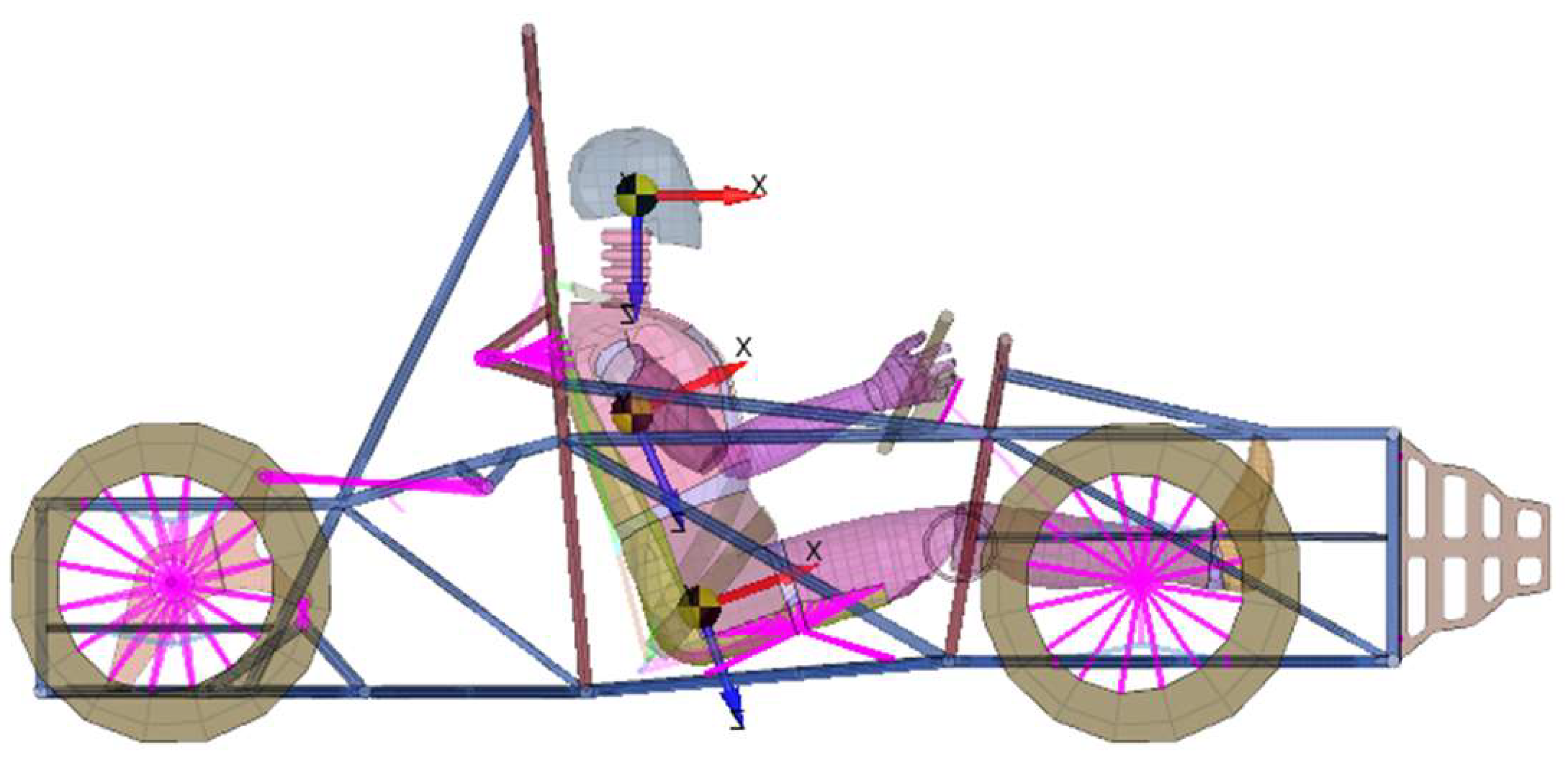
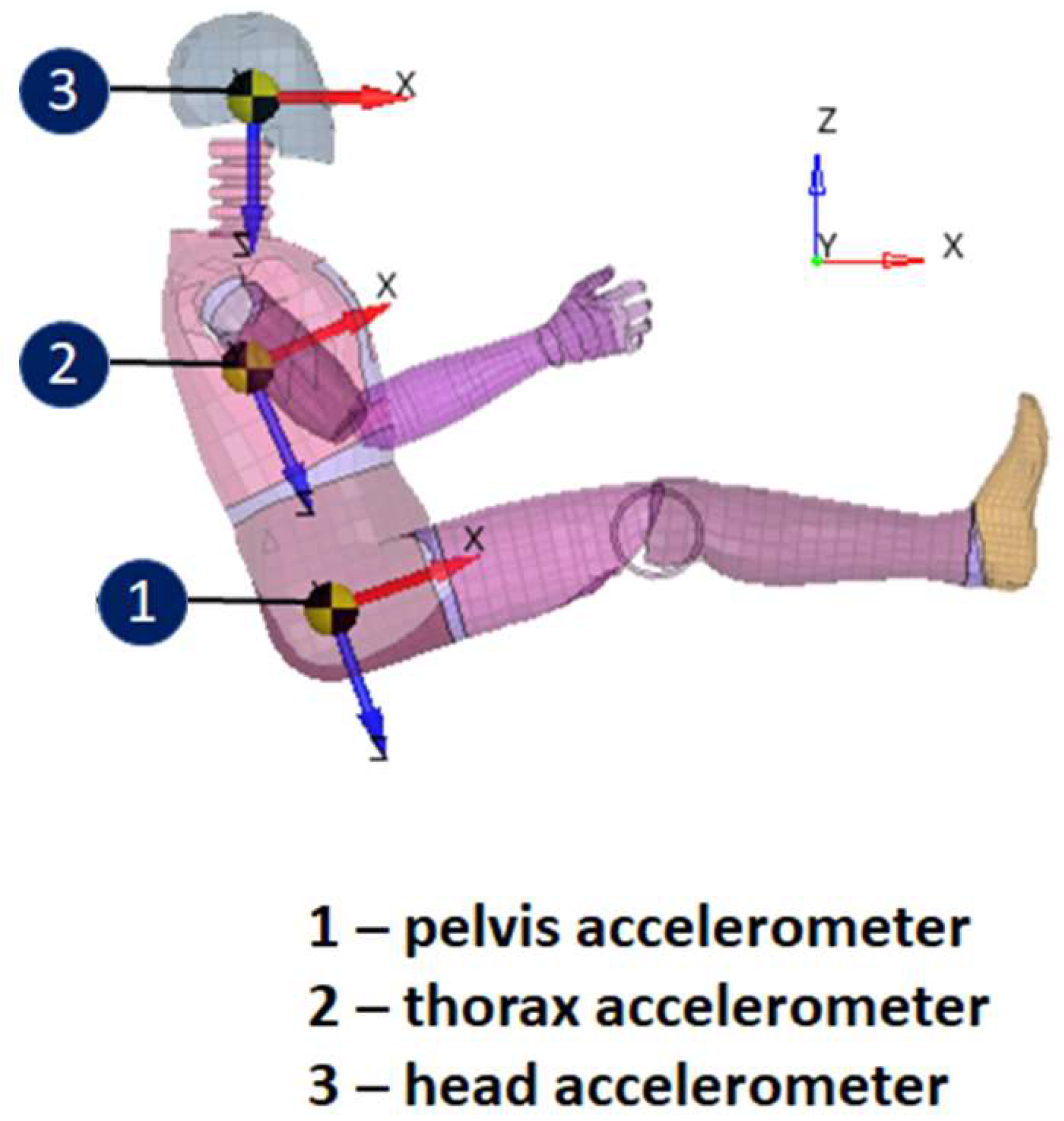
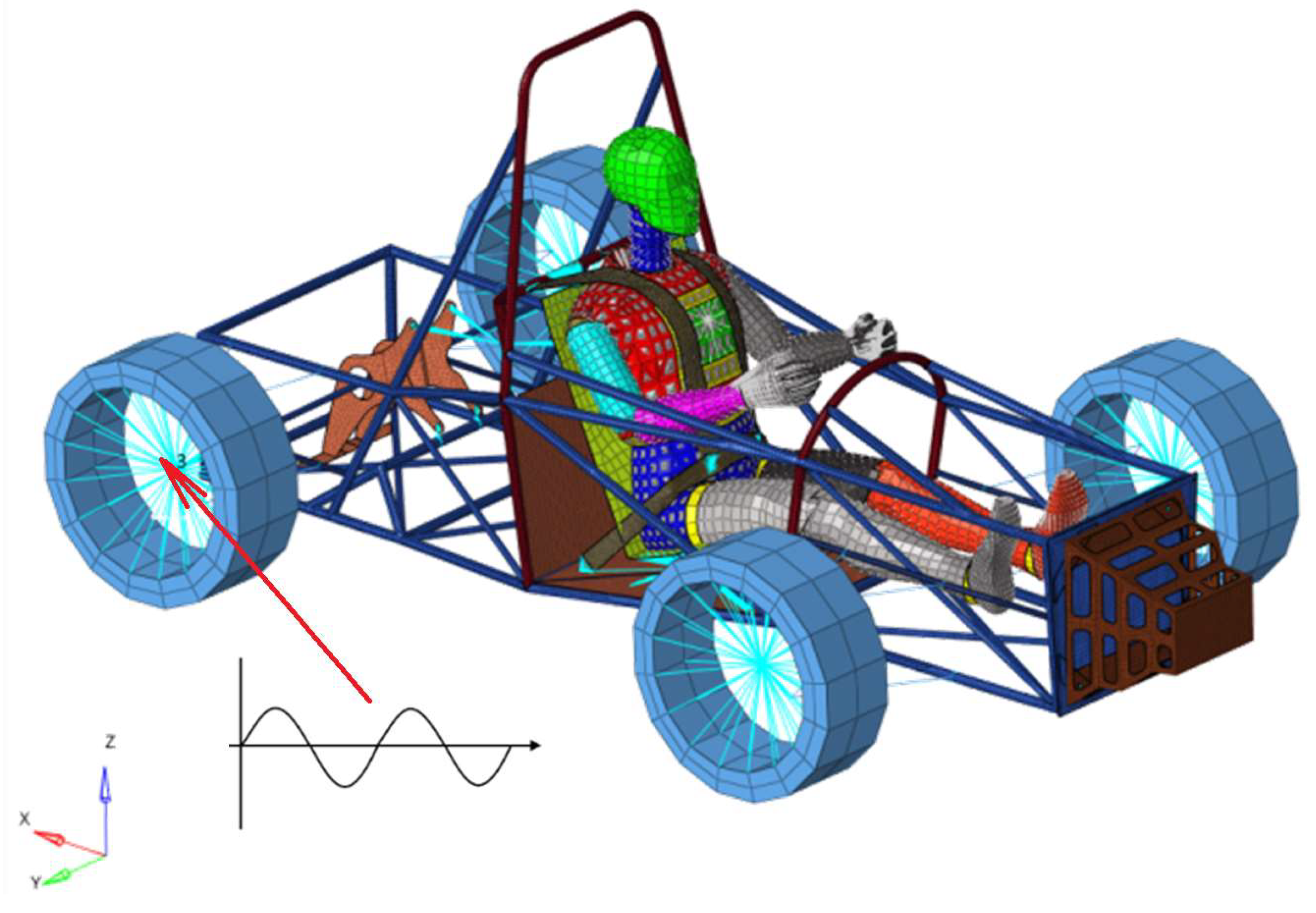
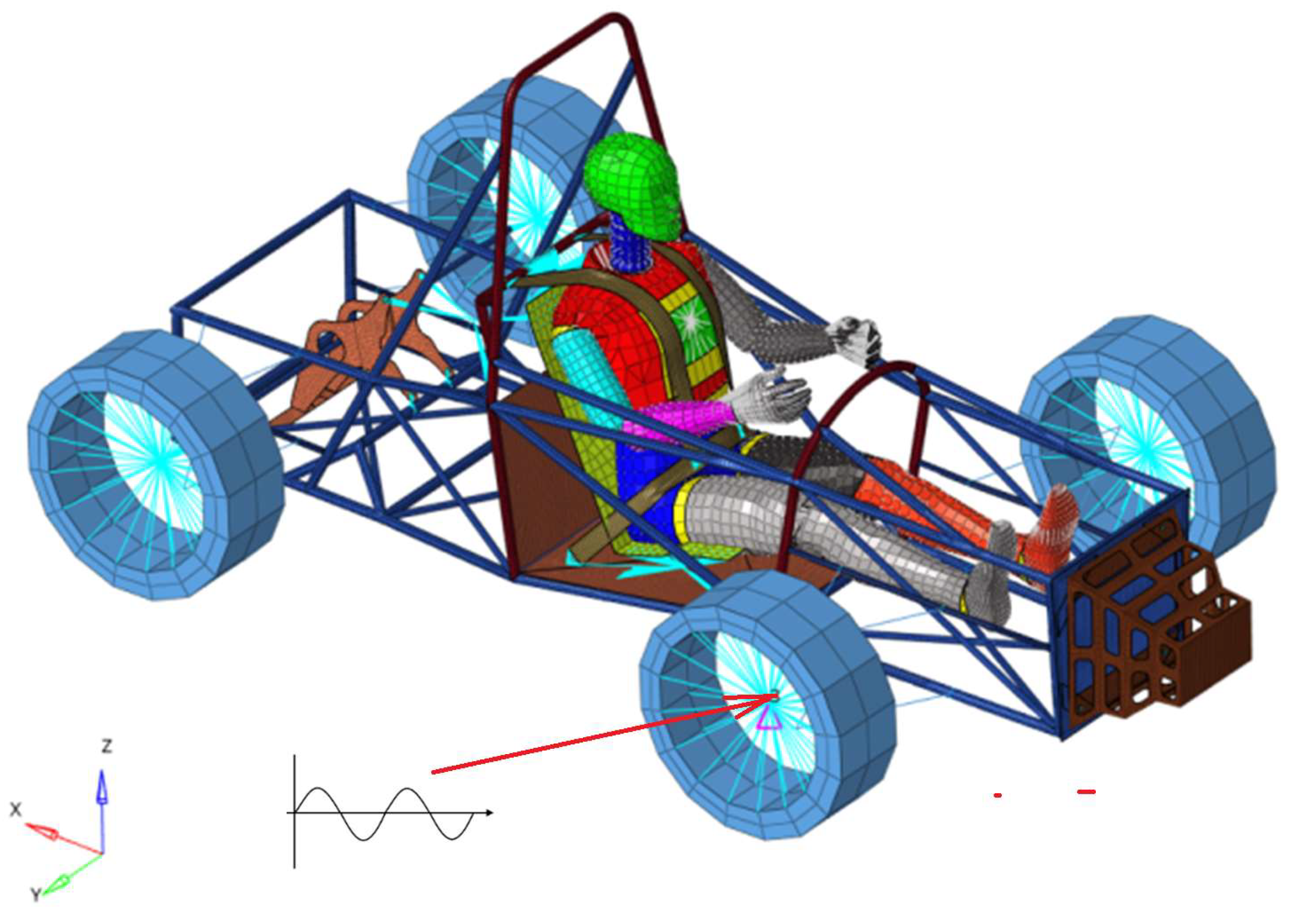
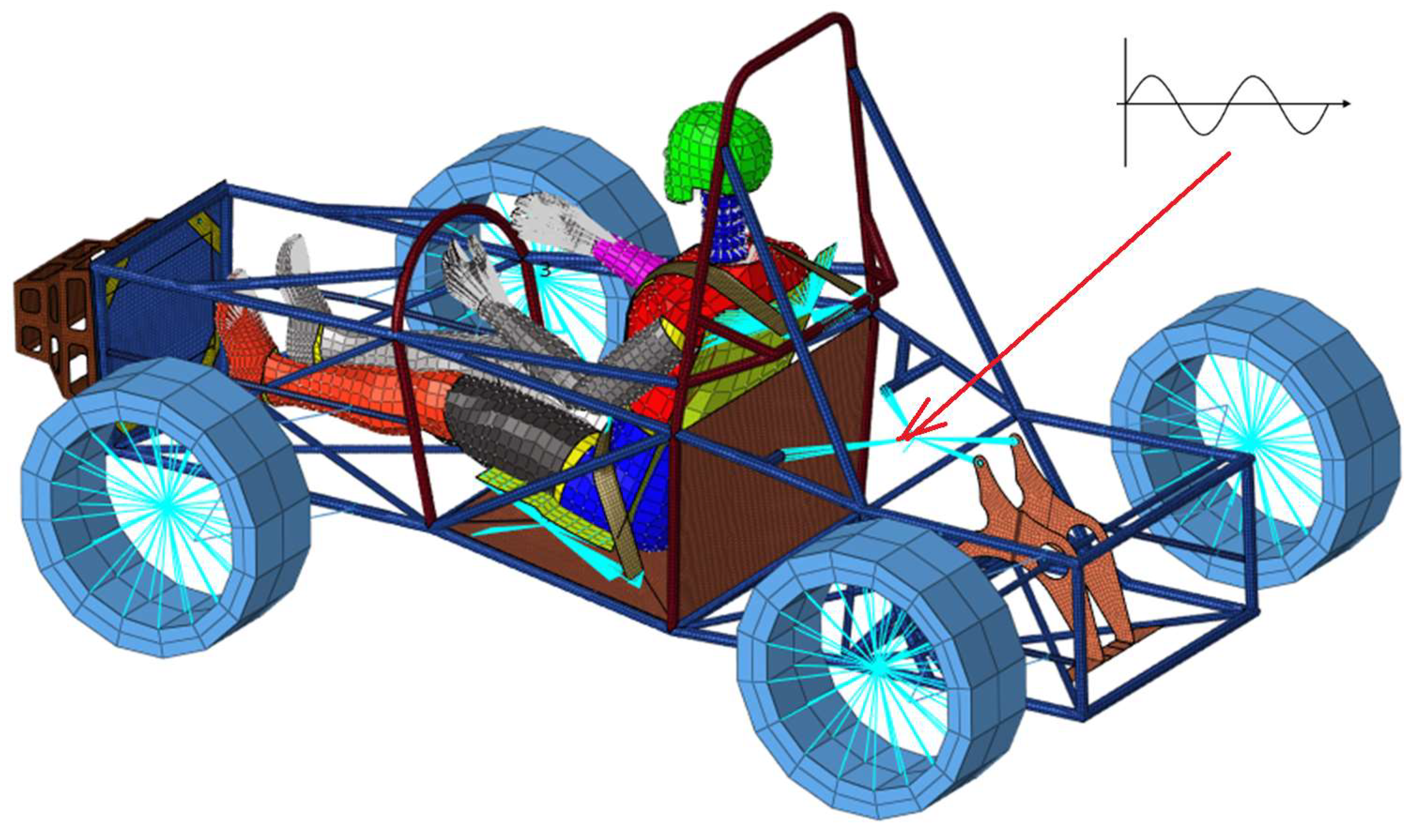
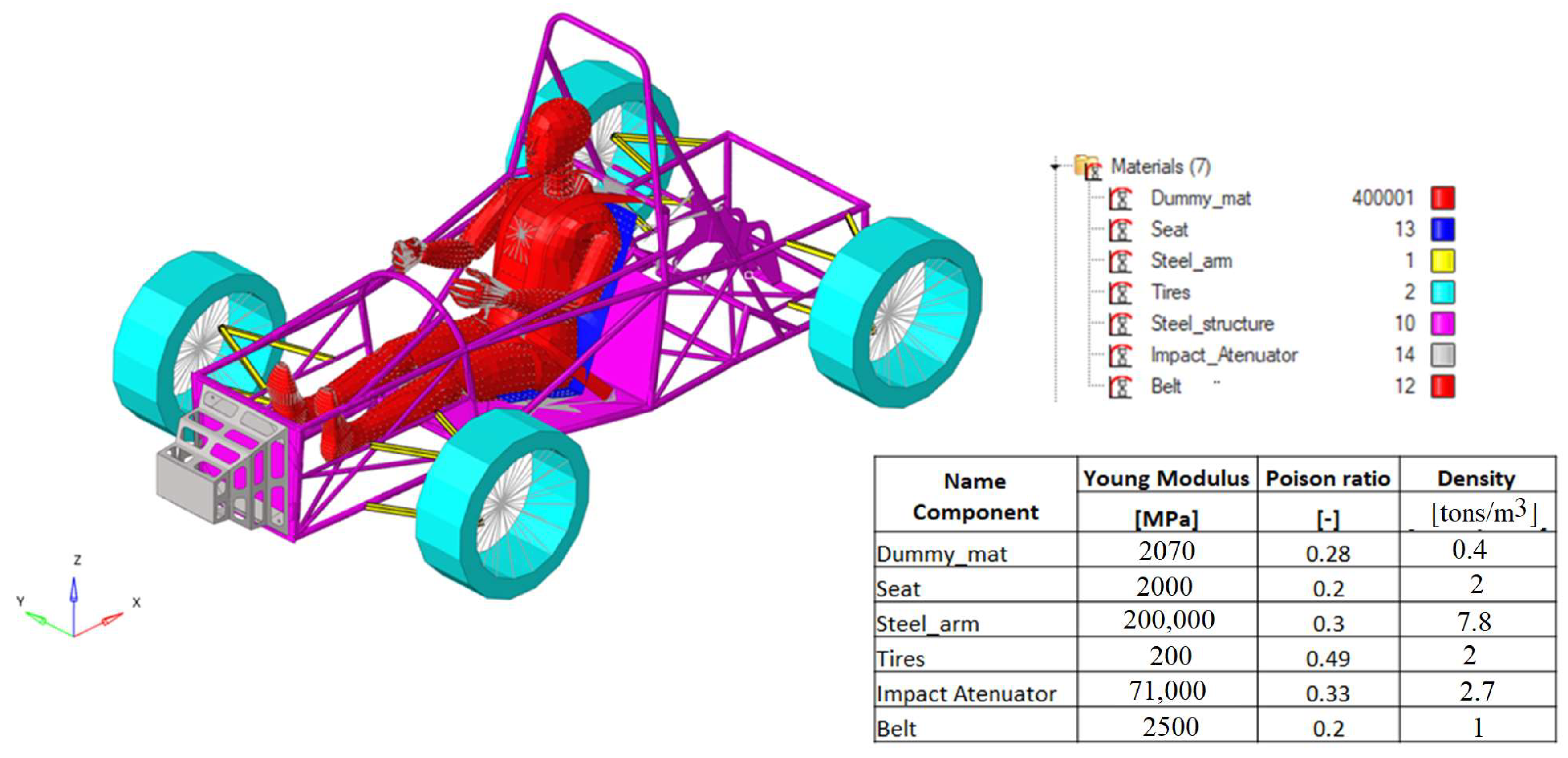


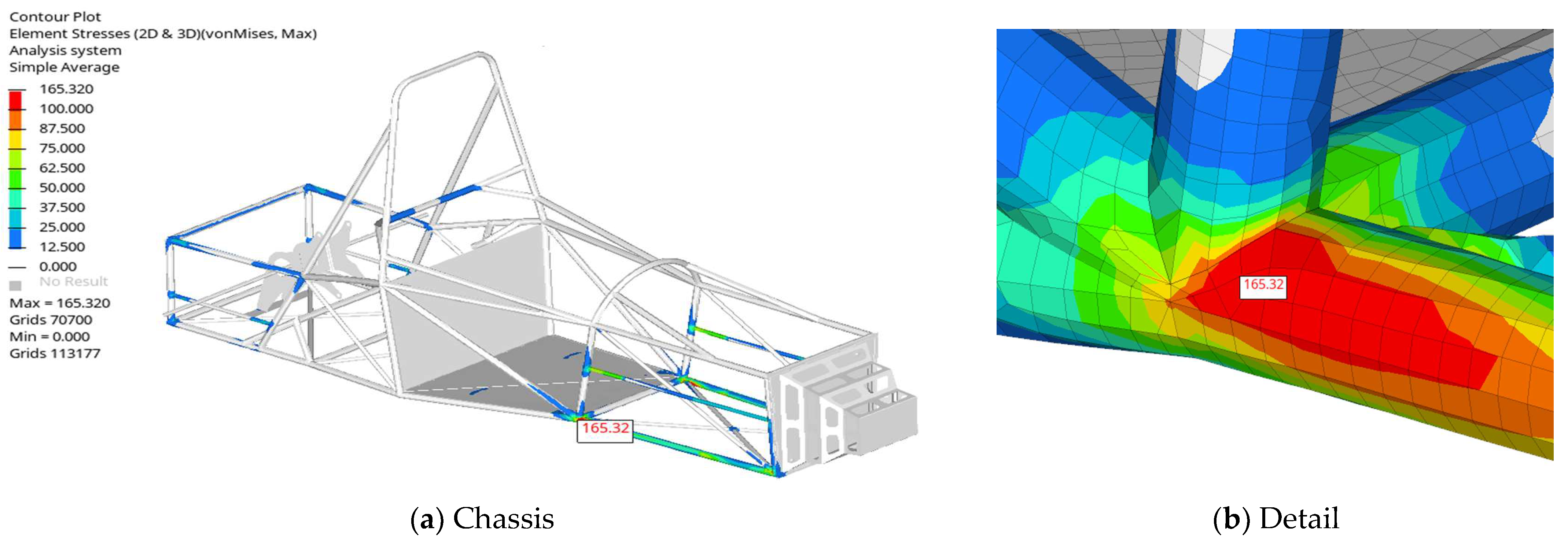
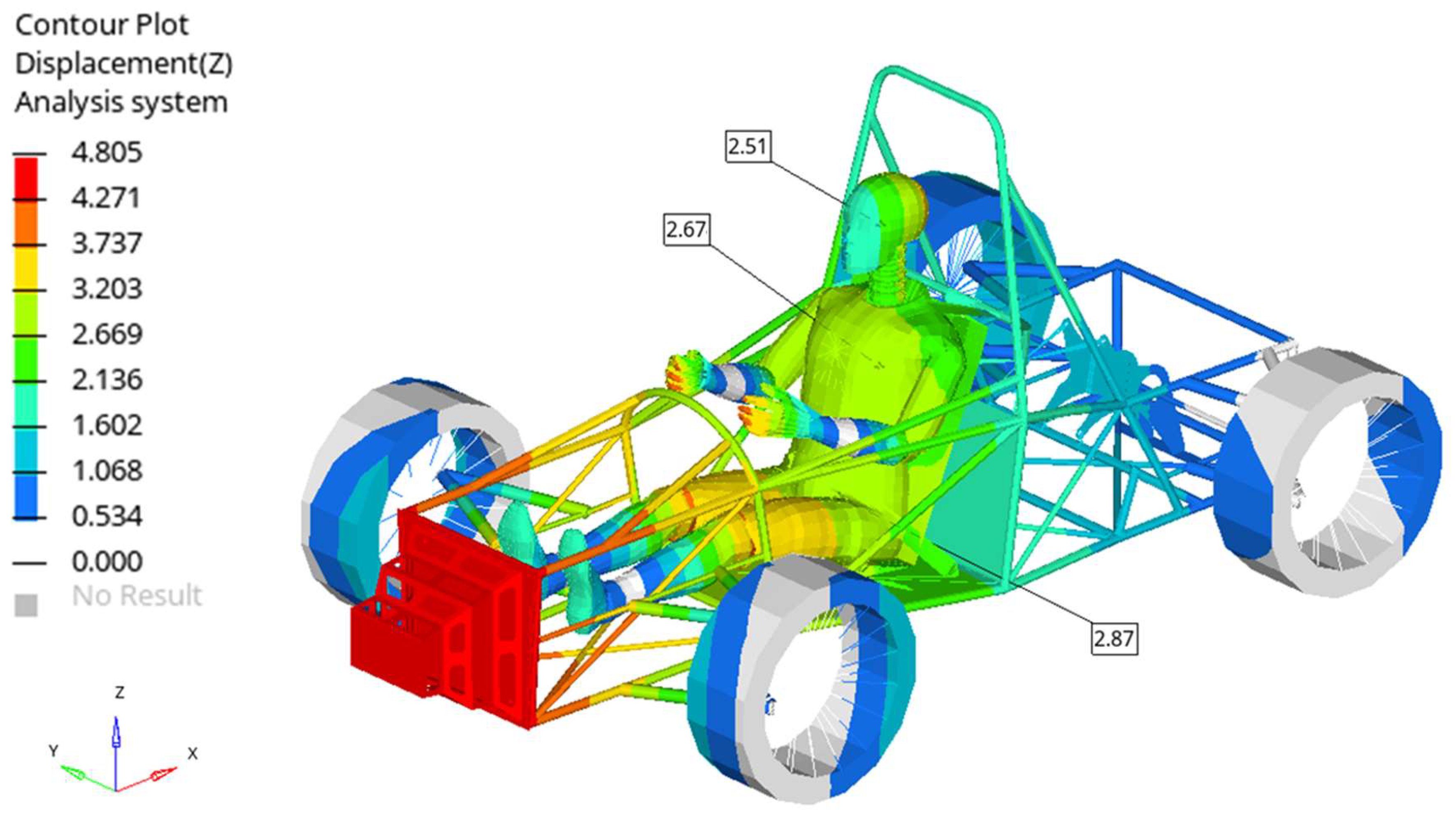
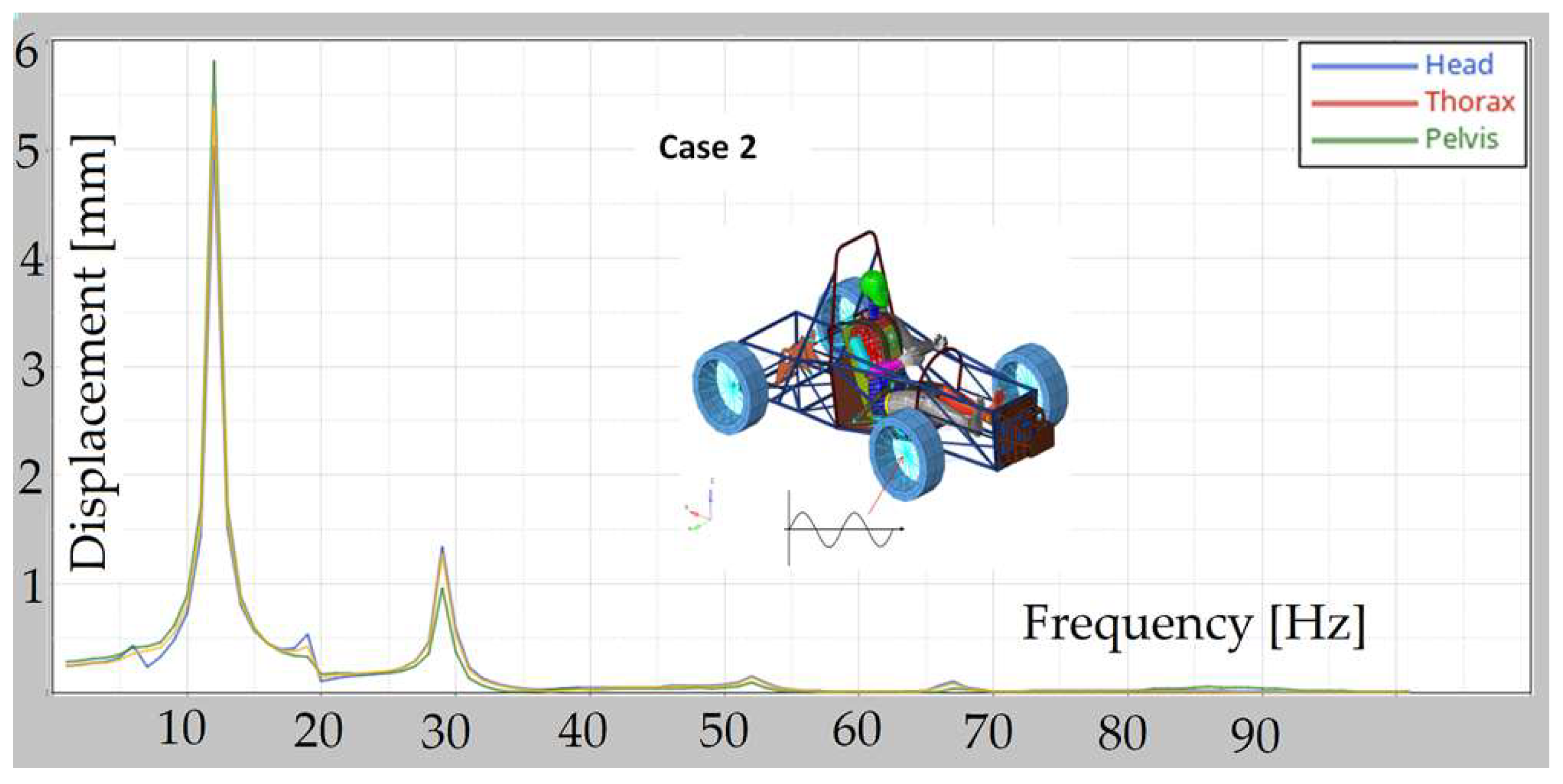

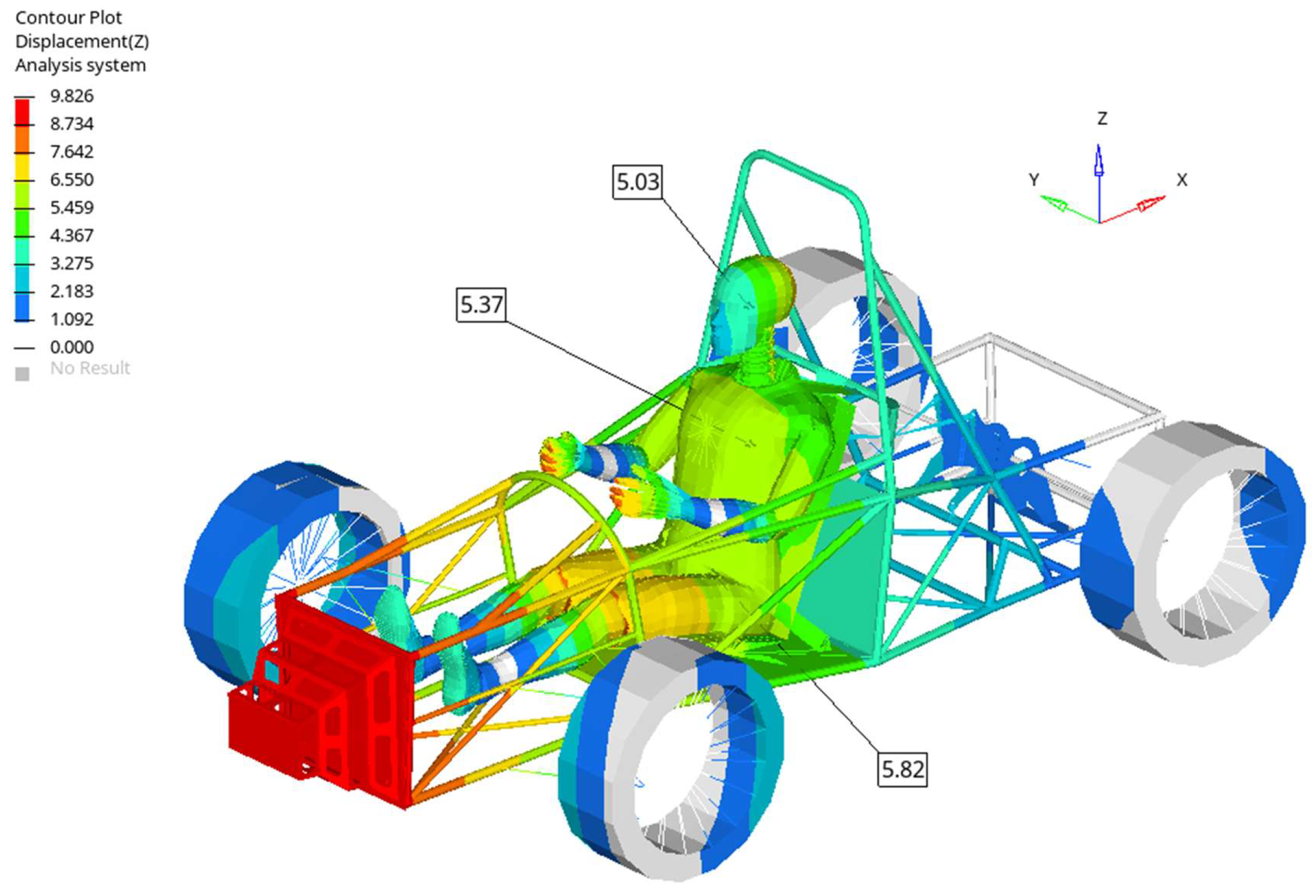
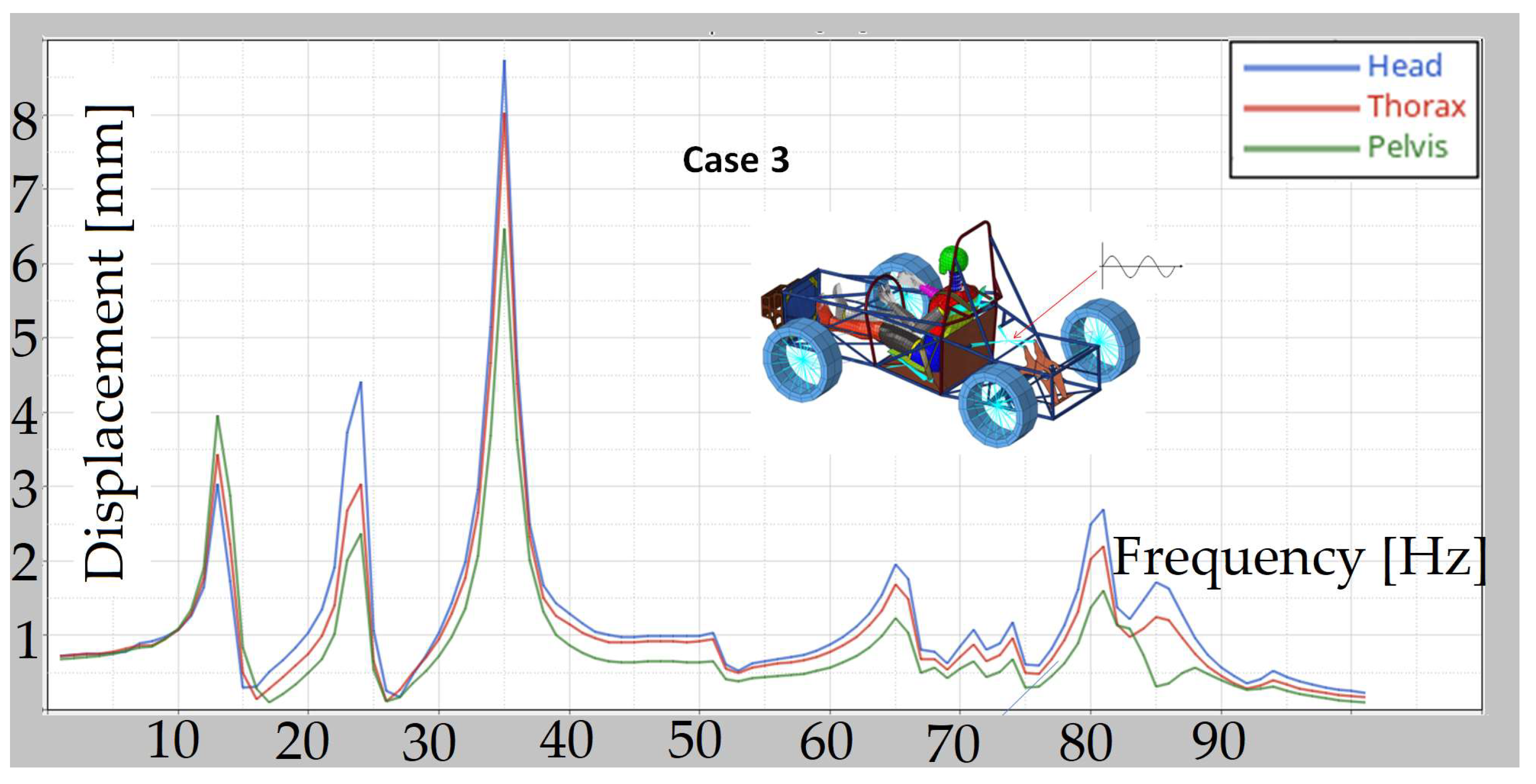
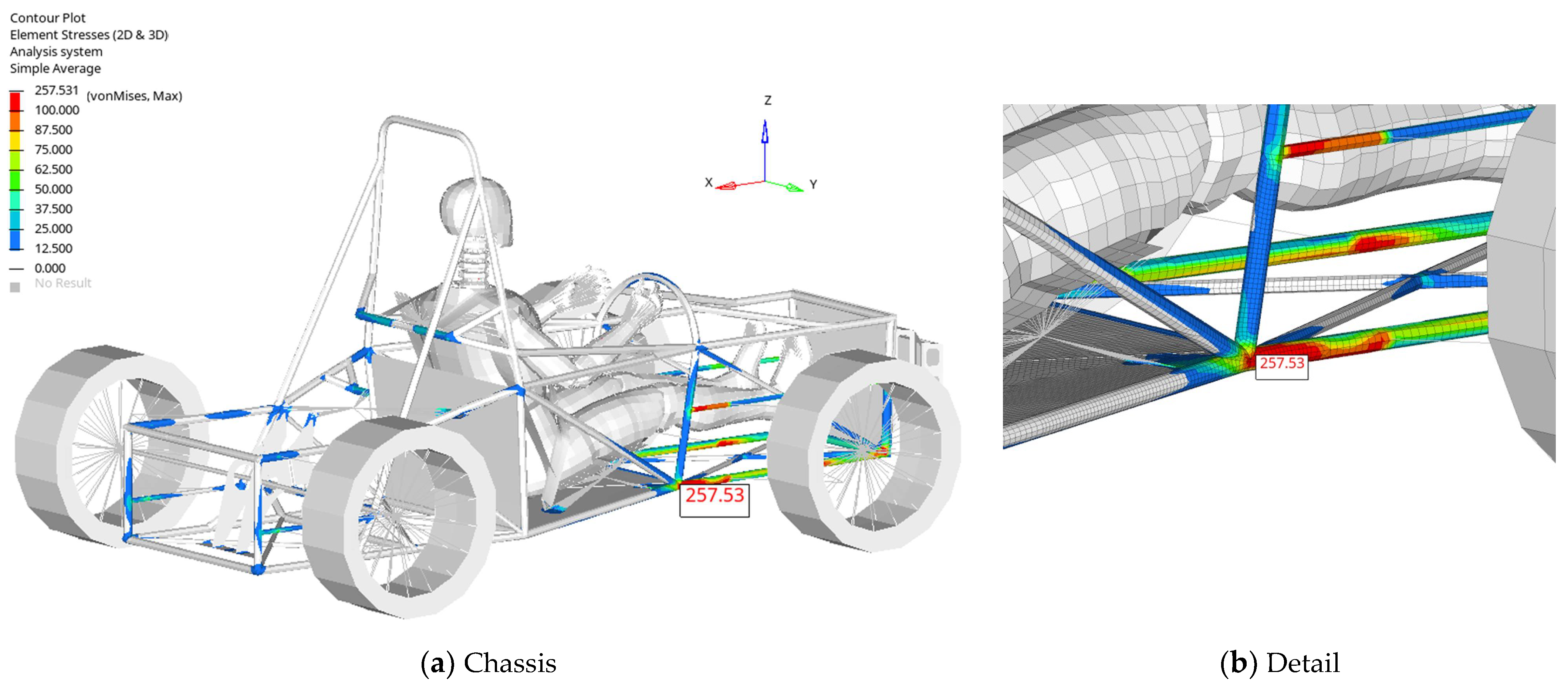
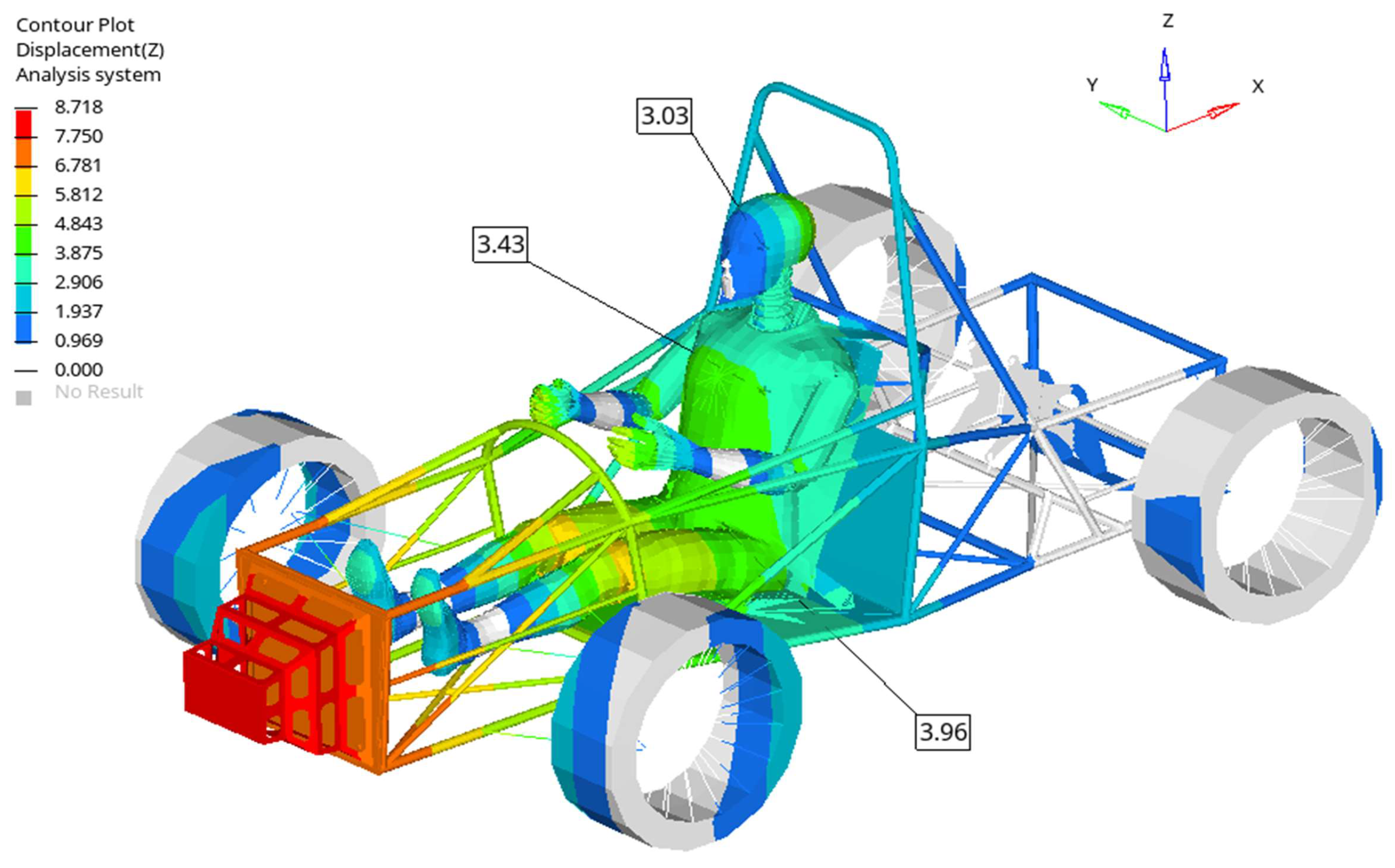
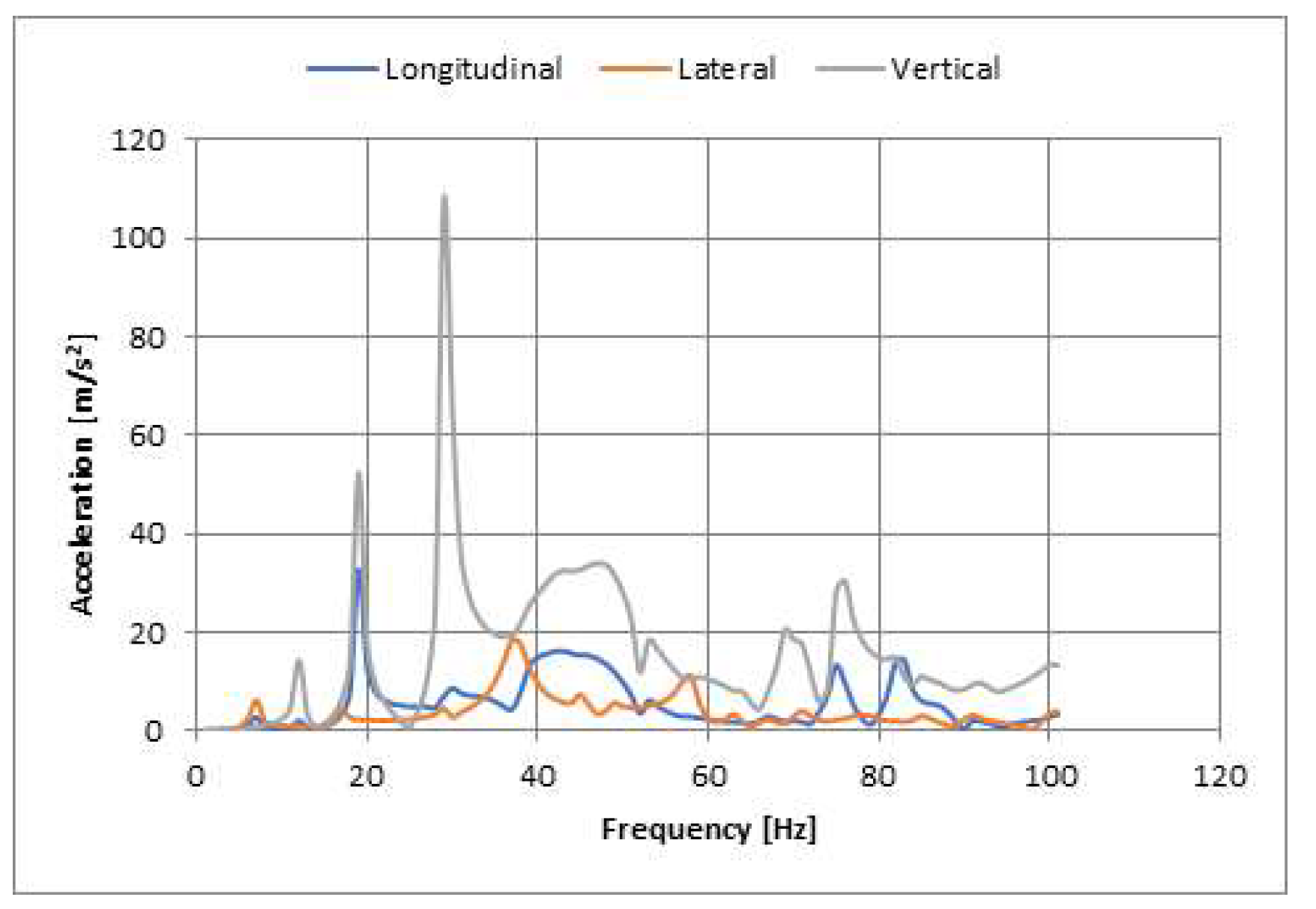

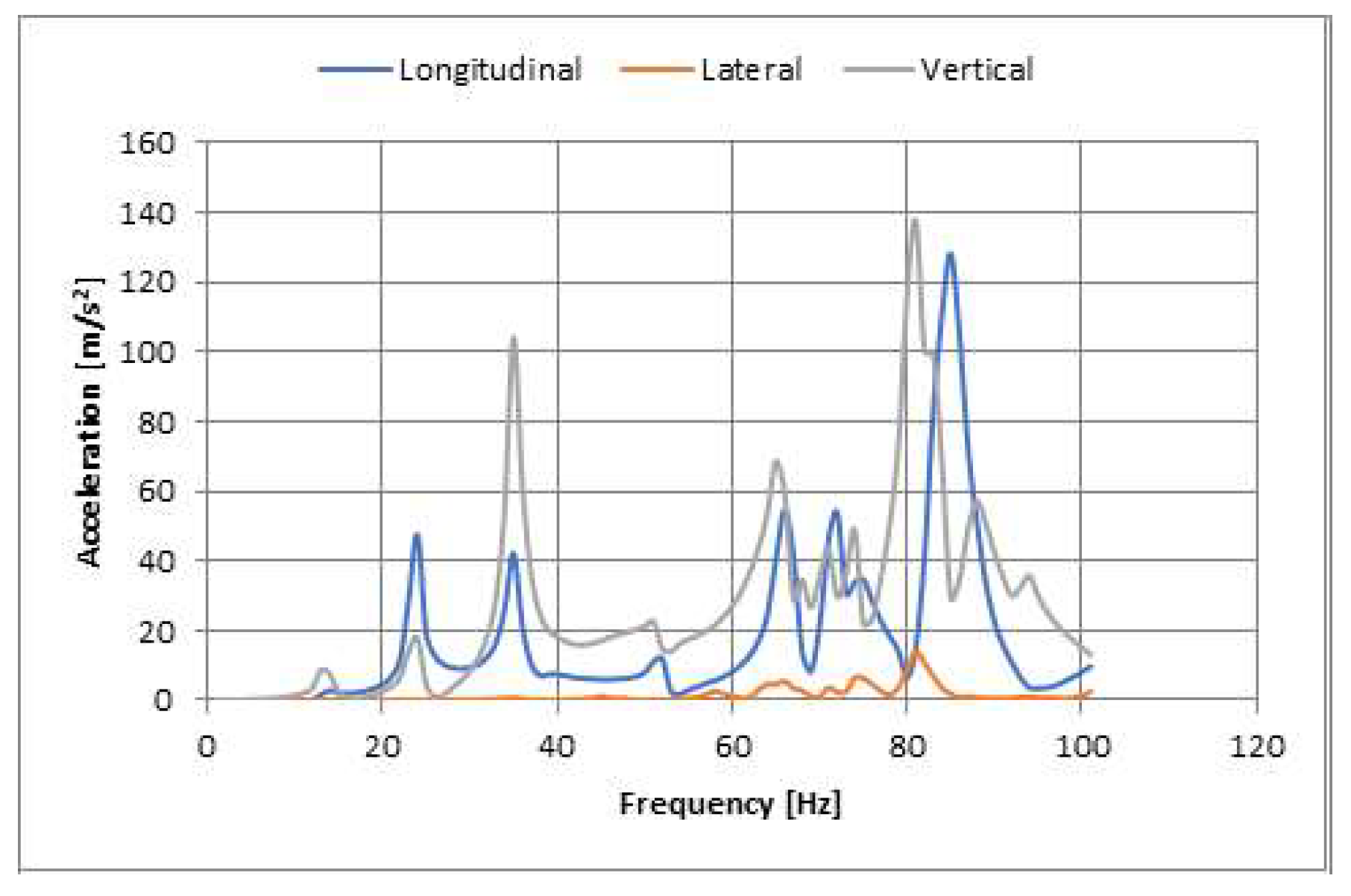
| Mode | Frequency [Hz] | Mode | Frequency [Hz] | Mode | Frequency [Hz] | Mode | Frequency [Hz] |
|---|---|---|---|---|---|---|---|
| 1 | 3.75 | 17 | 29.25 | 33 | 52.59 | 49 | 75.73 |
| 2 | 3.84 | 18 | 31.24 | 34 | 57.75 | 50 | 77.97 |
| 3 | 3.87 | 19 | 31.24 | 35 | 60.59 | 51 | 82.30 |
| 4 | 3.89 | 20 | 31.24 | 36 | 62.62 | 52 | 83.45 |
| 5 | 6.63 | 21 | 31.24 | 37 | 64.55 | 53 | 83.96 |
| 6 | 6.71 | 22 | 34.11 | 38 | 66.52 | 54 | 84.40 |
| 7 | 6.94 | 23 | 36.27 | 39 | 67.00 | 55 | 85.09 |
| 8 | 6.95 | 24 | 38.34 | 40 | 67.63 | 56 | 86.33 |
| 9 | 6.98 | 25 | 38.46 | 41 | 68.30 | 57 | 87.19 |
| 10 | 7.09 | 26 | 40.09 | 42 | 68.87 | 58 | 90.41 |
| 11 | 12.02 | 27 | 43.16 | 43 | 69.20 | 59 | 92.84 |
| 12 | 15.01 | 28 | 44.15 | 44 | 70.73 | 60 | 93.20 |
| 13 | 16.71 | 29 | 44.31 | 45 | 71.07 | 61 | 98.02 |
| 14 | 18.46 | 30 | 45.45 | 46 | 72.41 | 62 | 98.92 |
| 15 | 18.59 | 31 | 48.24 | 47 | 74.95 | 63 | 99.30 |
| 16 | 19.03 | 32 | 51.56 | 48 | 75.24 | 64 | 99.75 |
Disclaimer/Publisher’s Note: The statements, opinions and data contained in all publications are solely those of the individual author(s) and contributor(s) and not of MDPI and/or the editor(s). MDPI and/or the editor(s) disclaim responsibility for any injury to people or property resulting from any ideas, methods, instructions or products referred to in the content. |
© 2023 by the authors. Licensee MDPI, Basel, Switzerland. This article is an open access article distributed under the terms and conditions of the Creative Commons Attribution (CC BY) license (https://creativecommons.org/licenses/by/4.0/).
Share and Cite
Itu, C.; Sorin, V. The Effect of Vibrations from Racing Cars on the Human Body in FORMULA STUDENT Races. Appl. Sci. 2023, 13, 12150. https://doi.org/10.3390/app132212150
Itu C, Sorin V. The Effect of Vibrations from Racing Cars on the Human Body in FORMULA STUDENT Races. Applied Sciences. 2023; 13(22):12150. https://doi.org/10.3390/app132212150
Chicago/Turabian StyleItu, Calin, and Vlase Sorin. 2023. "The Effect of Vibrations from Racing Cars on the Human Body in FORMULA STUDENT Races" Applied Sciences 13, no. 22: 12150. https://doi.org/10.3390/app132212150






